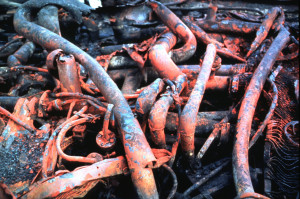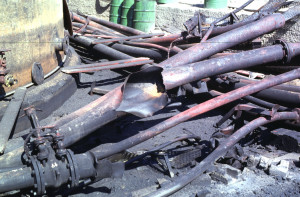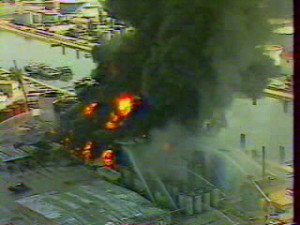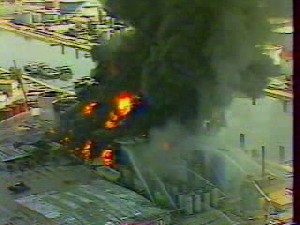At 1:15 pm in an oil depot, an aerosol sparked. One minute later, an explosion occurred that was perceptible several km away. The fire spread and in just a few minutes, several tanks containing hundreds of m³ exploded, sending them as high as 200 m aboveground and emptying their contents into the basin. All internal response equipment was destroyed. The external emergency plan was activated at 2:30 pm. Fire-fighters cooled the tanks with water and then attacked the 4,500-m² basin fire using foam. At around 6 pm, as the fire was receding, Tank No. 6, measuring 2,900 m³ and filled to 1/3 its level with diesel, produced a loud whistling noise before bursting and forming a fireball 300 m high by 200 m wide. It partially subsided outside the basin. Intervention equipment was damaged, while the foam supplies were nearly depleted as the fire intensified. The adjoining dock was isolated by a floating boom; moreover, sewer networks were buffered and the neighbouring chemical product depot was protected. The blaze extended to the adjacent basin and gasoline tanks ignited. The fire receded and was contained at 2 pm on 3rd June; the emergency plan was lifted at 7:45 pm.
For more than 24 hours, 200 fire-fighters were deployed and applied over 200 m³ of emulsifier. Two subcontractors were killed, 6 fire-fighters and 8 technicians injured, 5 of whom seriously. The depot was destroyed, with 1,900 m³ of diesel, 1,200 m³ of gasoline and 600 tonnes of additives released. Hydrocarbons infiltrated into the soil, and 10,000 m³ of extinction water were pumped and treated in south-eastern refineries. The water table was monitored until 2001. Property damage was estimated in 1987 currency at 130 million francs.
In 1996, judicial experts adopted the hypothesis of a maintenance deficiency on a petroleum additive racking pump left turned on at a zero racking rate, causing it to heat and a gap to form through which the flammable liquid discharged and then self-ignited. On 21st December, 2000, the company was found guilty of 2 deaths and sentenced to pay 1.4 million francs to the plaintiffs, with the depot director sentenced to 15 months of prison and a 30,000-franc fine.
The accident began in the additive mixing zone, where products became unstable as of a temperature of 130°-160°C; the zone was being renovated though other tanks were still operating, with disassembled bund walls, workstations left in place, etc. The situation was worsened by an explosion of the additive tanks, which were known to be fragile; a lack of automated or remote means for closing tank foot valves; and the presence of alcohol compounds, reducing emulsifier efficiency. The fireball created during the explosion of Tank No. 6, designed to hold sodium and with a roof considered fragile, might have been related to a tank pressurisation or similar phenomenon, in assuming that the valves, calibrated at 175 mbar, were unable to evacuate the pressure differential due to product vaporization.
Download the detailed report in .pdf format (725 Kb)







